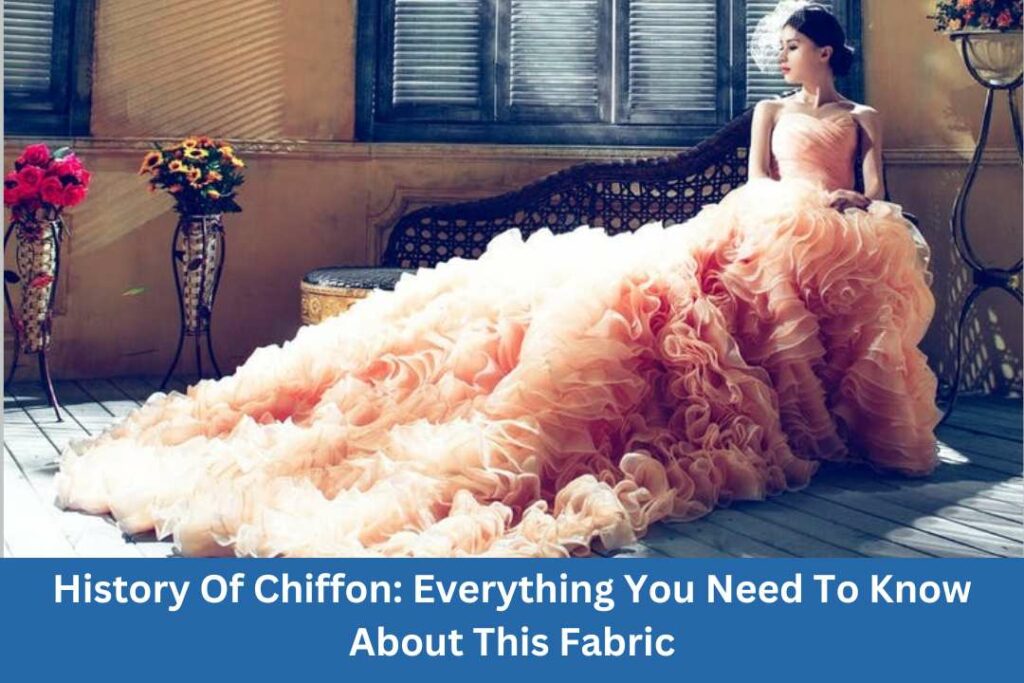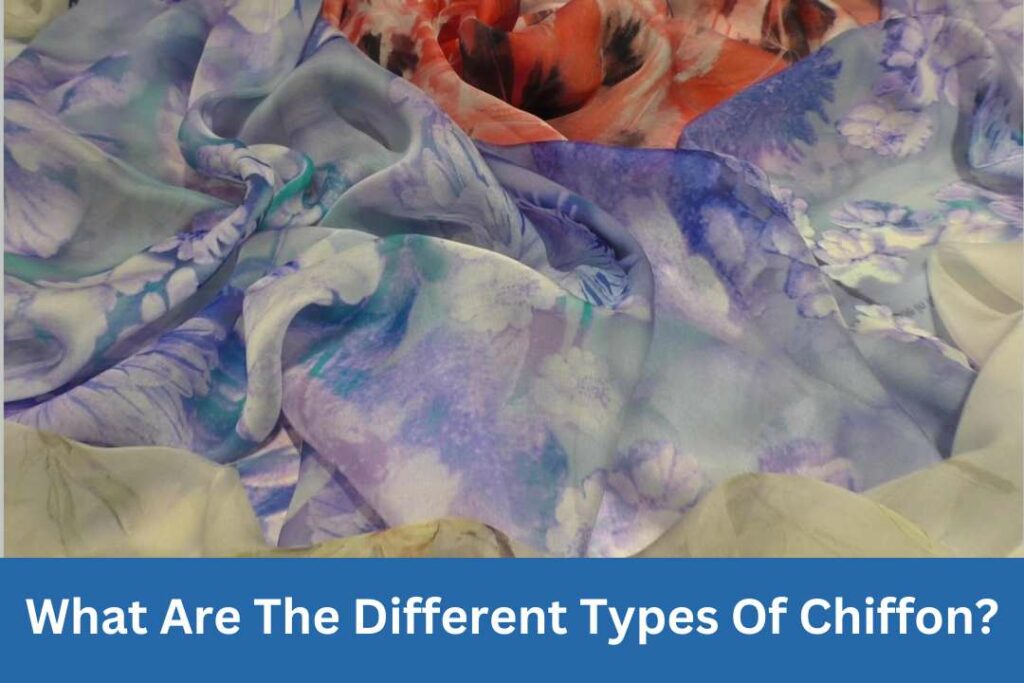
What Is Chiffon?
Ever wondered what makes those dreamy, flowy dresses so magical? Well, of course you did. That’s why you are reading this right now. So let me introduce you to chiffon – the secret behind that enchanting elegance!
Chiffon is like a whisper of fabric, super light and see-through. It’s made from really fine threads of silk, polyester, or nylon. Think of it as the fairy godmother of fabrics, giving your outfits that graceful, airy feel.
In this article, we’re going to dive into the world of chiffon, from where it comes from, its rich history to why it’s adored by fashion lovers worldwide. So, if you’re ready for a journey into the land of softness, sophistication and style, let’s get started!
What Is Chiffon?
Chiffon is a lightweight and sheer fabric that feels soft and delicate to the touch. It is usually made from silk, cotton, or synthetic fibers like polyester. The key characteristic of chiffon is its airy and transparent quality, making it a popular choice for elegant and flowing garments like evening gowns and scarves.
Its fine texture gives a luxurious look, and its draping ability adds a graceful touch to clothing. Whether it’s for a formal event or a stylish everyday outfit, chiffon brings a touch of sophistication with its subtle sheen and ethereal feel. Remember, dry cleaning or gentle hand washing is the most convenient way to maintain the delicate nature of chiffon.
History Of Chiffon: Everything You Need To Know About This Fabric

Chiffon fabric has a fancy history! The word “chiffon” originally comes from French, meaning “rag” – but don’t let that fool you. This fabric is super elegant. It started in China around 1700, made only from silk, and later traveled to Europe to make luxurious clothes for fancy people.
Back in the 19th century, chiffon became a big deal, especially for making beautiful lingerie. People were so into it that they called it “chiffon worship.” At first, it was only made from expensive silk, showing off wealth and abundance. But then, nylon came along, making chiffon more affordable. In 1958, polyester joined the party, making it even more popular due to its cost and durability.
Nowadays, chiffon is a star in fashion, used for evening dresses, blouses, wedding dresses, dance costumes, and more. It’s suitable for embroidery and decorations like beads and crystals because of its transparent nature.
Chiffon isn’t just about silk, cotton is also used, giving the fabric a different feel. It’s generally light and feels a bit rough. Although it can handle wear and tear, be cautious – it frays easily and doesn’t like hot irons or steam.
So, next time you wear chiffon, remember its journey from silk luxury to a versatile fabric that adds flair to all kinds of outfits!
What Are The Characteristics Of Chiffon?
Airy and Lightweight: Chiffon is incredibly light, allowing air to flow through it easily. In warmer weather this quality makes chiffon a demanding fabric for clothing.
Timeless Transparency: One of Chiffon’s notable features is its timeless transparency. This adds a perfect touch of elegance to garments, creating a classic and enduring appeal.
Soft to the Touch: Chiffon is soft and smooth in texture, so it feels very comfortable and smooth on skin. So unsurprisingly it’s a very popular choice for various clothing items, including evening gowns and scarves.
Effortless Movement: Chiffon is characterized by its effortless movement. The fabric flows smoothly, allowing for graceful and unrestricted motions, making it an excellent choice for dance costumes and flowy dresses.
Versatile and Stylish: The versatility of chiffon fabric helps in keeping it a demanding fabric till date. Its adaptive nature can make stylish clothes for casual and formal occasions, contributing to its popularity in the fashion world.
What Are The Different Types Of Chiffon?

A Guide to Different Types of Chiffon, a fabric synonymous with grace and sophistication, comes in various types, each possessing its unique characteristics. Let’s look into the world of chiffon and unravel the secrets behind its diverse variations.
1. Georgette Chiffon
Georgette chiffon is known for its delicate and sheer texture, providing a flowing and ethereal drape. The fabric is perfect for an elegant evening wear and formal occasions.
2. Silk Chiffon
Crafted from silk fibers, silk chiffon exudes luxury with its natural sheen. This variant is revered for its smooth texture and is often the fabric of choice for bridal gowns and high-end fashion creations.
3. Nylon Chiffon
Nylon chiffon combines durability with versatility. It is a resilient fabric that can withstand wear and tear, making it suitable for both casual and formal attire. Its affordability added to its benefit making it a popular choice for various fashion applications.
4. Polyester Chiffon
Polyester chiffon offers an economical alternative without compromising on style. It mimics the luxurious appearance of silk chiffon while being more pocket-friendly, making it a practical choice for those seeking elegance without creating a hole in their pocket.
5. Cotton Chiffon
Cotton chiffon combines the elegance of chiffon with the comfort of cotton. It’s breathable and lightweight, making it an ideal choice for warmer climates. This type of chiffon is perfect for summer dresses and casual chic outfits.
6. Crepe Chiffon
Crepe chiffon introduces a textured element to the traditional smooth surface of chiffon. This added texture enhances the visual appeal. People who want a more intricate and detailed fabric generally go for this one.
7. Satin Chiffon
Satin chiffon combines the smoothness of satin with the lightness of chiffon. As a result we get a subtle sheen fabric and a luxurious feeling. It’s often chosen for formal dresses and evening gowns.
What Are Chiffon Used For?
Elegant Dresses: Chiffon is widely celebrated for its use in creating elegant dresses. The fabric’s lightweight and flowing nature make it a popular choice for special occasions, adding a graceful touch to gowns and formal attire.
Stylish Scarves: Chiffon scarves are versatile accessories that effortlessly enhance everyday outfits. These scarves not only provide a chic finishing touch but also offer a breathable and comfortable option for various styles.
Curtains: Transforming into graceful curtains, chiffon lends a touch of sophistication to home decor. The fabric allows a gentle diffusion of light, creating an airy and elegant ambiance in living spaces.
Blouses: Chiffon blouses have become a staple in everyday fashion. The delicate texture of chiffon adds a subtle charm to casual wear, offering a stylish yet comfortable option for day-to-day dressing.
Wedding Gowns: Chiffon is a popular choice for crafting timeless wedding gowns. Brides adore the fabric for its romantic and ethereal qualities, creating a dreamy and elegant look for their special day.
Decorative Drapery: Chiffon is often used in home decor for creating decorative drapery. Its sheer and lightweight nature allows for a subtle and elegant window treatment, adding a touch of sophistication to living spaces.
Event Decor: Chiffon is used in event decor, for special occasions like weddings. It can be used for creating romantic and ethereal backdrops, canopy drapes, or as table runners, contributing to the overall ambiance.
Craft Projects: Crafters often utilize chiffon in various projects, such as making dreamy and delicate crafts like fabric flowers, bows, or decorative elements for DIY projects.
Photography Backdrops: Chiffon’s soft and flowing characteristics make it a popular choice for photography backdrops, adding a touch of elegance and capturing the beauty of movement in photoshoots.
Also Check: Is Evaless Legit? Read Before You Shop
Advantages and Disadvantages of Chiffon
Advantages:
- Chiffon is airy and lightweight, providing a comfortable feel against the skin.
- Its sheer and translucent quality adds a touch of sophistication and elegance to clothes.
- Chiffon allows air circulation, making it a breathable choice for warm-weather clothing.
- Chiffon drapes gracefully, hugging your curves.
- It can adapt well to various styles so suitable for both formal and casual wear.
- Chiffon is resistant to wrinkles, so it looks polished even after extended wear.
- It comes in a vast range of colors, offering versatility for diverse fashion preferences.
Disadvantages:
- Chiffon is delicate and prone to snags or tears, requiring careful handling.
- Its lightweight nature makes it tricky to sew, demanding skill and patience.
- Chiffon provides minimal insulation, making it less suitable for colder climates.
How To Wash and Handle Chiffon Fabric?
Chiffon is a comfortable, lightweight and very delicate fabric that adds a touch of elegance to any outfit. To keep your chiffon garments looking their best, you need to treat them with utmost care during washing and follow proper treatment methods.
Here’s a comprehensive guide to help you maintain the beauty of chiffon.
1. Hand Washing Chiffon
A. Use Cold Water:
When washing chiffon, opt for cold water to prevent fabric or color damage . Hot water may cause the fabric to lose its integrity.
B. Mild Detergent:
Select a gentle detergent that’s suitable to wash delicate fabrics. Using any strong detergent can damage the quality of your chiffon garments.
C. Gentle Swirling Motion:
Swirl the garment in the soapy water gently. Don’t run or wring excessively , as chiffon is prone to snagging.
2. Machine Washing Caution
While hand washing is preferable, if you choose to machine wash, take extra precautions.
A. Laundry Bag:
To minimize friction and prevent snagging, keep your chiffon garments inside a laundry bag.
B. Delicate Cycle:
Select the delicate or hand wash cycle on your machine to ensure a gentle washing process.
C. Avoid Harsh Detergents:
Just like with hand washing, use a mild detergent to protect the delicate fibers of chiffon.
3. Drying Chiffon Fabrics
A. Air Dry:
Place the chiffon garments in a dry clean place.
Allow it to air dry naturally to avoid stretching or distortion.
B. Avoid Direct Sunlight:
Keep chiffon away from direct sunlight during drying to prevent color fading.
C. Say No to Tumble Drying:
Never tumble dry chiffon, as the heat and agitation can damage the delicate fibers.
4. Ironing with Caution
A. Low Heat Setting:
If you want to iron the garments, set the low-heat temperature. High heat can cause irreversible damage to chiffon.
B. Use a Pressing Cloth:
Place a thin cloth between the iron and the chiffon to protect the fabric from direct heat.
5. Storing Chiffon Garments
A. Hang Carefully:
Hang chiffon garments using padded hangers to maintain their shape. Avoid overcrowding in the closet to prevent wrinkles.
B. Store in a Breathable Bag:
For long-term storage, use a breathable garment bag to protect chiffon from dust and insects.
Also Read: Is Flamingo Legit? Find Out Why You Shouldn’t Shop Here
What Are The Alternatives Of Chiffon?
Silk Georgette
Similar to chiffon, silk georgette is lightweight and has a smooth, luxurious feel, making it a stylish choice for various occasions.
Cotton Voile
If comfort is your priority, cotton voile provides breathability and a soft touch, perfect for casual and relaxed styles.
Crepe de Chine
Known for its luxurious texture and heavier drape compared to chiffon, crepe de chine adds a touch of sophistication to your attire.
Organza
For those special occasions, organza offers a sheer and crisp appearance, making it an elegant alternative.
Polyester Chiffon
If you’re on a budget, polyester chiffon provides a cost-effective option with qualities similar to traditional chiffon.
Satin
While slightly heavier, satin offers a luxurious look, making it suitable for formal and evening wear.
Rayon Challis
Seeking a versatile and lightweight option? Rayon Challis is comfortable and adaptable to different styles.
Linen Blend
For a natural and breathable choice with a textured look, consider a linen blend for a laid-back yet sophisticated appearance.
How to Sew With Chiffon?
Choose the Right Needle: Opt for a fine, sharp needle (size 9 or 11) to prevent snagging or tearing the delicate chiffon fabric.
Pin Strategically: Avoid pinning directly into the fabric, as it can leave visible holes. Instead, use fine silk pins within the seam allowance or along the fabric’s selvage.
Handle with Care: When working with chiffon, use a light touch to prevent stretching or distorting the fabric. Allow the fabric to feed naturally through the sewing machine.
Select the Appropriate Thread: Use lightweight, fine thread that matches the color of your chiffon fabric for seamless blending.
Reinforce as Needed: Strengthen areas prone to stress, like seams or edges, with lightweight interfacing or stay tape. This adds stability without bulk.
Practice Stitching Techniques: Experiment with different stitching methods such as French seams, narrow hems, or rolled hems to find the best finish for your project.
Test on Scrap Fabric: Before sewing on your main fabric, practice stitching techniques and settings on a scrap piece of chiffon to adjust tension and stitch length.
Handle Finished Garments with Care: After sewing, handle the finished garment gently to avoid pulling or stretching, preserving the delicate nature of chiffon.
By following these tips, you can confidently sew with chiffon and create beautiful garments without worry.
Frequently Asked Questions About Chiffon
Q1. Is chiffon suitable for summer clothing?
Q2. Can you wear chiffon in the winter?
Q3. Can chiffon be used for casual wear?
Q4. What colors are trendy for chiffon bridesmaid dresses?
Conclusion
So, here we have discussed every possible thing on chiffon. Imagine it as your closet’s glamorous masterpiece, a symbol of beauty passed down through the years. Let it hang in there, ready to unfold its stylish tales each time you wear it.
Chiffon is more than fabric – it’s a timeless companion, that’s constructing stories in threads and adding a touch of grace to your fashion journey.